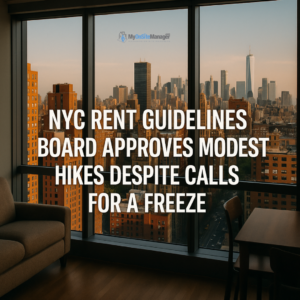New York City renters are bracing for higher costs after the Rent Guidelines Board (RGB) voted in favor of increasing rents on more than one million rent-stabilized apartments. Beginning in October 2025, tenants will see rent hikes of 3% for one-year leases and 4.5% for two-year leases.
While the decision was framed as a compromise, it quickly drew criticism from both sides. Tenant advocates argued for a full rent freeze, citing affordability concerns, while landlords said the increases were not enough to cover ballooning maintenance costs.
Why Rent Hikes Matter More Than the Numbers
At first glance, 3% or 4.5% may not seem dramatic. But in a city where rents are already among the highest in the country, the cumulative effect is significant.
-
A tenant paying $2,000 a month will now owe $2,060 on a one-year lease or $2,090 on a two-year lease.
-
Over a year, that means $720 to $1,080 in additional costs before factoring in utilities, transportation, and daily living expenses that are also on the rise.
For families and individuals living paycheck to paycheck, these increases can tip the scales toward food insecurity, debt, or even displacement.
Tenant Voices: Struggling to Keep Up
Tenant groups have been vocal in opposing the hikes. Many argue that wages have not kept pace with inflation, leaving households stretched thin.
-
Calls for a Freeze: Advocates say that New York is in the middle of a housing affordability crisis and that even modest rent hikes deepen inequality.
-
Fear of Displacement: Renters worry that the increases will push more families out of stabilized units and into an even tighter rental market.
-
Daily Trade-Offs: For many tenants, higher rent means cutting back on healthcare, childcare, or groceries just to make ends meet.
Tenant demonstrations leading up to the vote emphasized these realities, urging the board to recognize housing as a basic human need rather than a market commodity.
Landlords Push Back: “We’re Struggling Too”
Landlords and building owners, particularly small property owners, counter that they are also under financial strain. Rising property taxes, utilities, and repair costs have squeezed profit margins, and they argue that modest increases are necessary just to keep buildings habitable.
Without sufficient rent adjustments, landlords claim they risk falling behind on maintenance leading to leaky roofs, faulty plumbing, or unsafe living conditions.
For many, the approved 3% and 4.5% increases are seen not as generous, but as the bare minimum needed to offset ongoing inflationary pressures.
Politics at the Heart of Housing
Housing policy in New York is inseparable from politics, and this year’s vote underscores that reality.
-
Mayor Eric Adams urged the Rent Guidelines Board to adopt “the lowest increase possible,” stopping short of supporting a full freeze. His stance reflects the balancing act of protecting tenants while acknowledging landlord costs.
-
Councilmember Zohran Mamdani, a progressive lawmaker and mayoral hopeful, went further by demanding a freeze. He criticized the decision as siding with real estate interests at the expense of working-class New Yorkers.
-
With the 2025 mayoral race heating up, rent policy is poised to be a major campaign issue. Candidates will likely use the RGB’s decision as evidence of either protecting or failing the city’s renters.
This political tension highlights the broader question: who ultimately bears responsibility for keeping New York affordable landlords, tenants, or city leadership?
Broader Impact: One Million Homes on the Line
Rent-stabilized apartments are a cornerstone of New York’s housing system, providing a degree of affordability in an otherwise volatile market. Roughly one million units fall under these protections, housing a diverse population that includes seniors, families, and young workers.
The annual RGB vote doesn’t just affect tenants and landlords it reverberates across the city’s economy:
-
Neighborhood Stability: Rent increases can force families to relocate, disrupting schools, businesses, and community ties.
-
Homelessness Risk: Rising rents push vulnerable renters closer to eviction or homelessness.
-
Housing Market Pressure: As stabilized units become less affordable, demand for market-rate housing increases, driving prices higher citywide.
Looking Ahead: What’s Next for NYC Renters?
The decision leaves both sides unsatisfied, and the conversation around affordability is far from over. Looking forward, key questions remain:
-
Will tenants rally for stronger protections or even universal rent control?
-
Can landlords secure tax breaks or subsidies to balance their rising costs?
-
How will housing policy shape the outcome of the mayoral race and future city legislation?
The only certainty is that housing will remain one of New York’s most pressing and contentious issues.
Final Takeaway
The Rent Guidelines Board’s 2025 decision reflects the constant balancing act of New York housing policy. For tenants, a 3% increase may feel like a crushing blow. For landlords, it may feel like barely enough to stay afloat.
As wages stagnate and costs rise, the debate over affordability versus sustainability grows sharper. In the city that never sleeps, one thing is clear: the fight over rent isn’t going anywhere.

